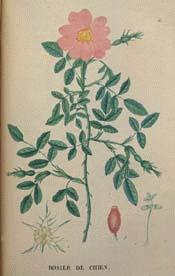
June 23
I didn’t post my usual flower of the day entry yesterday because my dog, Chester, died at 10 am in the morning. In his honor, I’m naming the dog rose, the flower of the day for June 23. The French Republican calendar honors the mule on this day since it’s the 5th of Messidor, while Rosa’s Dial assigns the pasque flower to this day, which seems odd since it’s usually associated with spring.
The dog rose is rosa canina, described in wikipedia http://en.wikiped
 ia.org/wiki/Dog_Rose
ia.org/wiki/Dog_Roseas a scrambling rose, and I love that for Chester was a scrambling dog. He loved to break loose and go on rampages, running through the neighborhood, chasing birds, squirrels and cats and eating garbage. I knew he was getting old (he was 15 when he died) because twice in the last few months, his collar slipped off over head while we were on a walk and he didn’t take off either time.
The dog rose is also called the sweet briar, briar rose, dogberry, wild briar and witches briar. It was the rose that grew up around Sleeping Beauty’s castle. The flowers vary in color from white to deep pink but are generally pink flowers, very thin and flat. The dog rose has lots of tiny thorns that help it grow, and produces bright red rose hips in the autumn. The rose hips are a great source of Vitamin C and can be made into syrup, jelly, jam, vinegars, soup (especially in Scandinavian cuisine), pies, tarts, quick breads, muffins, tea and wine. Rodale’s recommends substituting them for cranberries in recipes. During World War II, it was frequently planted in victory gardens in America. According to Laura Martin, gathering rose hips became a national pastime and the dog rose a patriotic symbol.
Mrs. Grieve has much to say about it in her herbal http://botanical.com/botanical/mgmh/r/roses-18.html
but you must page down past the rosa gallica and rosa centifolia to get to the dog rose. Hildegard of Bingen recommended rose hip tea as the initial treatment for just about every illness [Castleman]. Gerard, the Elizabethan herbalist says “The fruit when it is ripe maketh most pleasant meats and banqueting dishes, as tarts and such like; the making whereof I commit to the cunning cooke, and teeth to eate them in the rich mans mouth.”
Mr.s Grieve gives two explanations for the common name “dog rose.” One is that Pliny recommended it for dealing with dog bites. (Chester only bit other dogs, and he only bit light-colored terriers—we never figured out why. Maybe he knew that Waverly really wanted a Wheaten Terrier more than she wanted a Chester dog—that is a dog of dubious pedigree. The best we can figure out is that he was half spaniel and half black lab). The other explanation is that the name comes from dag, meaning dagger, referring to the thorns.
Here’s the poem my daughter wrote in honor of Chester:
Chester, my first dog,
You were never what we expected
But you were always you.
People think they own their pets
But in the end their pets own them.
Bouncing, bright, black dog, mischief maker,
You stole my boot; we never found it.
The boot and you are eternal.
Somewhere on a sandy shore
You will steal that boot forever.
Shaw Fitzgerald
June 23, 2006
References:
Castleman, Michael, The Healing Herbs, Rodale Press 1991
Gerard’s Herbal, edited by Marcus Woodward, Senate 1994
Martin, Laura C, Garden Flower Folklore, Globe Pequot Press 1987
2 comments:
I am incredibly sorry to hear of Chester's passing. May he rest well and know he was loved. ^_^ Your daughter's poem was lovely as well.
What a very sweet poem. We love our dog friends and miss them dearly when they pass on to the summerland...
Post a Comment